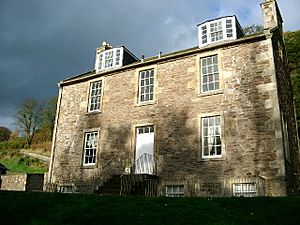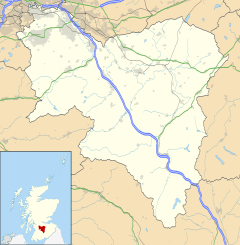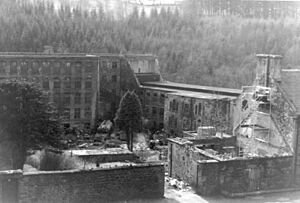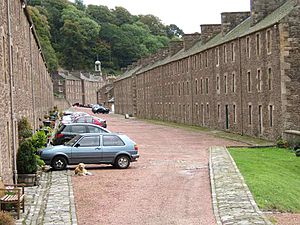New Lanark facts for kids
Quick facts for kids New Lanark
|
|
|---|---|
 New Lanark Mill Hotel and Waterhouses by River Clyde |
|
| Population | 200 (approx.) |
| Council area | |
| Lieutenancy area | |
| Country | Scotland |
| Sovereign state | United Kingdom |
| Post town | LANARK |
| Postcode district | ML11 |
| Dialling code | 01555 |
| Police | Strathclyde |
| Fire | Strathclyde |
| Ambulance | Scottish |
| EU Parliament | Scotland |
| UK Parliament |
|
| Scottish Parliament | |
New Lanark is a historic village in Scotland, located by the River Clyde. It's about 1.4 kilometers from Lanark and 25 miles southeast of Glasgow. The village was started in 1785 by David Dale. He built cotton mills and homes for the people who worked there.
Dale partnered with Richard Arkwright to use the powerful waterfalls of the River Clyde for the mills. Later, Robert Owen, Dale's son-in-law, took over. Owen was a philanthropist who believed in making life better for workers. New Lanark became a very successful business and an early example of a planned community. This makes it an important place in the history of urban planning.
The mills at New Lanark operated until 1968. After they closed, the village started to fall apart. In 1974, the New Lanark Conservation Trust (now called the New Lanark Trust) was created to save it. Today, most of the buildings have been restored. New Lanark is now a popular tourist attraction. It is one of seven UNESCO World Heritage Sites in Scotland. It's also a key spot on the European Route of Industrial Heritage.
Contents
A Look Back: New Lanark's History
New Lanark's cotton mills began in 1786. David Dale, a successful businessman from Glasgow, founded them. He worked with Richard Arkwright, who invented new water-powered cotton spinning machines. Dale chose this spot because of the strong water power from the Falls of Clyde.
Robert Owen's Vision
In the early 1800s, Robert Owen became the manager and a part-owner of New Lanark. Owen was an industrialist who cared deeply about his workers. He wanted to improve their lives, much like his father-in-law, David Dale. Owen's ideas were part of what is called Utopian socialism. This meant he wanted to create a perfect society where everyone was treated well.
Owen focused on helping the 500 children living and working in the village. In 1817, he opened the first infants' school in Britain. He also built the Institute for the Formation of Character in 1816. This was a place for education and community activities.
Water Power and Progress
The New Lanark mills relied on water power from the River Clyde. A dam was built, and water was directed through a tunnel and a channel called a lade. This water then turned large water wheels inside the mills. These wheels powered the machinery. Even today, water power is still used. A new water turbine in Mill Number Three generates electricity for the village's tourist areas.
Challenges and Success
About 2,500 people lived in New Lanark during Owen's time. Many came from poorhouses in Glasgow and Edinburgh. Owen found the living and working conditions needed improvement. He proved that a business could be profitable while also treating its workers well.
Owen's partners were not happy about the extra money spent on welfare programs. But Owen bought them out to continue his reforms. Many important people from across Europe visited New Lanark. They were amazed to see a clean, healthy factory town with happy workers and a successful business.
After Owen
In 1825, Robert Owen left New Lanark to start a new community in the United States. The Walker family then managed the village until 1881. The mills continued to operate under different owners until they finally closed in 1968.
After the mills closed, the village began to decline. Buildings started to fall apart. In 1974, the New Lanark Conservation Trust was formed to save the village from being torn down. The Trust worked hard to restore the historic buildings. By 2005, most of the village was restored.
Life in the Village: Living Conditions
In the mid-1800s, families in New Lanark often lived in just one room. You can see what these homes were like by visiting the reconstructed Millworkers House at New Lanark. The David Livingstone Centre in Blantyre also shows similar living conditions.
Over time, living conditions improved. By the early 1900s, families had several rooms. It wasn't until 1933 that homes got indoor cold water taps and private indoor toilets. Before that, people used shared outdoor toilets.
From 1938, the village owners provided free electricity. However, there was only enough power for one dim light bulb in each room. The electricity was turned off at 10 pm on weekdays and 11 pm on Saturdays. In 1955, New Lanark finally connected to the national electricity supply.
New Lanark Today
Today, over 400,000 people visit New Lanark each year. In 2001, UNESCO recognized its importance by making it a World Heritage Site. Other Scottish World Heritage Sites include Edinburgh Old and New Towns and the Forth Bridge.
About 130 people still live in New Lanark. Many of the residential buildings have been restored. Some were bought by private owners, while others are rented out by the New Lanark Trust.
In 2009, Clydesdale Bank featured New Lanark on the back of its new £20 Scottish banknotes.
Great care is taken to keep the village looking historical. For example, no television aerials or satellite dishes are allowed. All external wood is painted white, and doors and windows follow a consistent design. This helps maintain the village's historic appearance.
The New Lanark Trust owns and operates the mills, the hotel, and most of the other buildings.
Important Buildings in New Lanark

- Braxfield Row: Built around 1790, this building now has ten homes.
- Long Row: Also built around 1790, it has 14 homes today.
- Double Row: Built around 1795, these homes were occupied for nearly 200 years. One part, called 'Museum Stair', still has original items like fireplaces and wallpaper.
- Wee Row: Built around 1795, this building was once a youth hostel.
- New Buildings: Built in 1798, this building has a bell tower. The bell used to call workers to the mills.
- Nursery Buildings: Built in 1809, this building once housed the orphan children who worked in the mills.
- Caithness Row: Built in 1792, it was named after a group of Highlanders who came to work in the mills.
- Village Church: Built in 1898, it is now used as a community hall.
- Mill Number One: First built in 1785, it burned down and was rebuilt in 1789. It is now the New Lanark Mill Hotel.
- Waterhouses: Built between 1799 and 1818, these buildings are now holiday flats.
- Mill Number Two: Built in 1788, it is now used for tourist activities.
- Mill Number Three: Built between 1790 and 1792, it also burned down and was rebuilt. It now helps generate electricity for the village.
- Institute for the Formation of Character: Built in 1816, this four-storey building is used for tourism and business.
- Engine House: Built in 1881, it has a restored steam engine.
- School: Built in 1817, this building was home to the first school for working-class children in Scotland. It is now a museum.
- Owens House and Dales House: Both built in 1790, these were the homes of Robert Owen and David Dale. They are now museums or business offices.
- Graveyard: Located on the hill above the village, it is where many of the first villagers are buried.
Visiting New Lanark
There is a large car park outside the village for visitors. Only disabled visitors can park inside the village itself. The walk from the car park offers great views of New Lanark. You can also take a bus (Number 135) from Lanark station. Lanark railway station has trains from Glasgow every half hour.
In the village, you'll find a four-star hotel (the New Lanark Mill Hotel) and holiday flats (the Waterhouses). There are also restaurants, shops, and a visitors' centre. All these are run by the New Lanark Trust.
The Clyde walkway, a long walking path, goes through the village. The Scottish Wildlife Trust also has a visitor centre here for the Falls of Clyde Nature Reserve.
See also
 In Spanish: New Lanark para niños
In Spanish: New Lanark para niños
- Saltaire
- Crespi d'Adda
- Company Town





